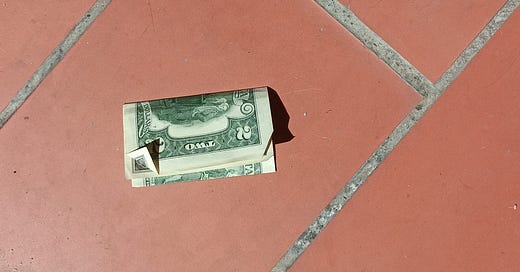The other day while walking in a working-class barrio of Barcelona, I found a $2 bill — noticing it because some chica chatting on her phone walked right over it.
How odd, I thought, to find a $2 bill in Spain — in a neighborhood totally ignored by tourists, no less. I unfolded it, seeing the image of Thomas Jefferson on the front, the signing of the constitution on the back, and noticing the stamped “Series 2017 A” to Jefferson’s right.
It wasn’t one of those rare $2 bills — for example, the 1976 bicentennial one with three printing errors that was sold for around $10,000 not long ago.
Nevertheless, this bill felt special – and not just because I’d found it – there’s nothing more glorious than finding ID-less money with no potential owner in sight – and not only because it was a two-dollar bill, a denomination I hadn’t seen for decades.
This bill was carefully folded into four parts — who folds their bills into neat little rectangles, with two of the corners neatly creased as well? — making it seem like a keepsake, a symbol, a lucky charm perhaps, that succumbed to gravity and fell out of someone’s wallet or a special pocket. I wondered if its previous owner was mourning its loss, retracing their steps through the ‘hood.
And finding this special bill made me feel special, too.
Until, that is, I started bragging about it.
The first friend I mentioned it to, a Brit, informed me that $2 bills are fake. I assured him my find was not, in fact, “as phony as a $3 bill” being a $2 bill, and urged him to feel it. He admitted it felt legit. (The next day he found five euros. Frequently, after I tell somebody I found money, they find some, too.)
The second friend I told, an American, wasn’t impressed. He owned thousands of two-dollar bills, he said – having inherited them from his parents, who used to collect them, he wasn’t sure why. (My later research indicated that many people hang unto them, believing them very rare, which they aren’t. However, since so many people collect them — and other issues that I’ll get into — they are scarcely circulated.)
The third friend I told, a German, rolled her eyes. “Oh, I find $2 bills all the time,” said Izzy. (In all the thousands-of-dollars-worth of money I’ve found across the planet, I’ve never before found one $2 bill.) To her recollection, she’d found five of them – three in the U.S., one in Canada, and, oddly, one in Vietnam. (Izzy, who is 26-ish, is fairly amazing. She travels all over the world by herself.)
But even if NOBODY ELSE was wowed by my sidewalk find, I still was. (You know me – easily impressed.) So I started doing research, not knowing that it would lead me to tears. (Really – bawling over a $2 bill. Well, you’ll see why.)
Turns out the $2 bill has quite the reputation.
The Odd History
Even though the $2 bill was introduced as legal tender the same time as the $1 bill — 1862, when it had Alexander Hamilton on the front — it’s never been embraced like its sister bills. Apparently the problem goes back centuries — to when buccaneers were trading with Spain, and two dollars was worth 13 Spanish reales, and thus considered jinxed.
Even when they slapped Jefferson on the front, the bill, which was nicknamed a “Tom,” it became a symbol of the sinister and debauched.
In the 1800s, it’s said, some politicians bought votes for $2, making the bill a token of bribery. In the early 1900s, when prostitutes charged two dollars a trick, the same prices as a minimum bet at the horse races, the innocent li’l bill became associated with those two vices as well.
What’s more, there was another strange luck factor woven into its identity. Some believed that since it’s a “deuce” — a slang term for the devil — that it was cursed, unless you ripped off a corner; then it brought good luck, or not, depending on the circumstances.
As described in a 1925 New York Times article, its lack of use, negative connotation, and mutilation was costing the federal government $1 million a year. “He who sits in a game of chance with a two-dollar bill in his pocket is thought to be saddled with a jinx,” wrote the reporter. “The only place where it is supposed to consort happily with Lady Luck is at the race track where, strangely, it is relied on to bring good fortune.”
So many $2 bills had their corners ripped off and had to be returned to the treasury, that in 1966 the government phased them out and stopped printing them.
However, for the American Bicentennial in 1976, the $2 bill was reissued with a design change — the back now shows the signing of the constitution instead of Monticello. But even now, they elicit mixed reactions — including that some American cashiers won’t accept them, believing they’re faux. And while some still consider them bad luck, others view them as good luck (at least if you fold a corner) and carry them in their wallets as a charm.
The Sad Story
Among those who carried meaningful, neatly folded $2 bills in their wallets were Myrta and Robert J. Gschaar of New York. The notes held special meaning: when the two were married, Robert couldn’t afford to buy wedding rings, so they exchanged $2 bills instead. The reason: they were each getting married for the second time, being given a second chance, and it likewise emblemized they were two of a kind.
So they carried their $2 bills with them wherever they went, even after Robert landed a good job and bought wedding rings. And so on a fateful September day, it was with Robert when he called his wife from the South Tower of the World Trade Center, saying something had happened to the North Tower, and he was evacuating and would call her when he was out of the building.
That phone call never came.
A few years later, police notified Myrta that they’d found Robert’s wallet — containing, among other things, his WTC ID and his revered $2 bill. She donated it to the National September 11th Memorial and Museum.
Reading that, I started sobbing, which was embarrassing because I was on the palm tree terrace of a cool cocktail bar, Torre Rosa. And I decided that I should probably go drop that $2 back on the sidewalk, in case it was Myrna’s or held equal value to whoever lost it. Now if I can just recall exactly where I found it.







Also, about the folded corners- I read this in a magazine once- if you need to roll a bill into a very tight circle it only lasts if you tuck a corner into itself.
Wait, Hamilton was on the $2? Now he’s on the $10. How did that punk get a raise? Okay okay, Treasury Secretary shot fair and square during a dual with a possible insurrectionist - I get that. Who was on the $10 before getting deleted for the wanna-be-royalist?
Speaking of Hamilton dying, one of my most clever facebook posts was about that one single time I was acting like a drunken sailor ( as IF ) and I commented on my free spending manner with this recap “I was dropping more Hamiltons than Aaron Burr.”